DESN 232 — RAPID VIZ I | FALL 2019 | T/TH 4:00–6:45PM
PROCESS
PART ONE
EXPLORATORY
SKETCHES
A minimum of 60 study sketches a specific animal (insect, reptile, amphibian, mammal, bird, fish) while mechanizing the form—mech design—retaining key attributes of proportions, stance, attitude, etc. while articulating a functional purpose for their end product.
Your product's application and it’s use must become clearly defined.
Create a list of analysis needs from research with similar or related devices.
Solutions are provided using analogy and through research.
A recommendation is made that leads to simple configuration drawings. Gesture drawing (introduced in the previous assignment) should be used to discover new styling aesthetics.
Number your sketches.
All sketches must be complete.
A silhouette without complete detailing is NOT a valid sketch.
Medium / Materials
You may use an alternative paper such as black or a mid-tone Canson and use a white Prismacolor Verithin pencil instead of graphite or ink pen. Trim the Canson paper to approximately 14x17.
8-10 sketches per sheet, well organized, 10 sheets total.
DRAW LARGE!
Organize your sketches like the example(s) provided below. Adjust as necessary for your particular form; a long skinny form will require a different organization than a thick blocky form.
Include your name in the lower right corner of each sheet for the Professor's documentation purposes.
All sketching is monochromatic only. Use Prismacolor (or similar) pencils; indigo, sepia, burnt umber, crimson red, black, etc. However, DO NOT mix color on a given sheet (like the example from Christian below). Each sheet, one color. If you want to use a different color because you're bored,
use a new color on the next sheet.
DO NOT JUMP TO PART TWO UNTIL YOU HAVE RECEIVED
APPROVAL TO MOVE AHEAD
Part 1a by Jecky Chow Chen. Explorations of a variety of animal types prior to moving forward with the Beetle. Fall 2014
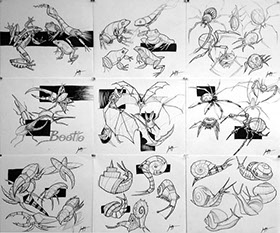
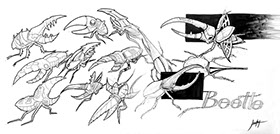
Part 1 by Tomas Castro. Fall 2014
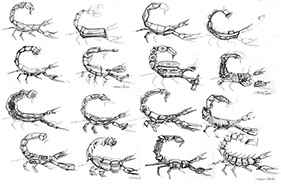
Part 1 by Christian Pacpaco. Spring 2012. Cataloged process

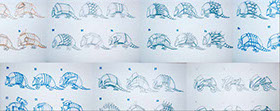
Part 1 by David Touch using ink and white Prismacolor pencil on a textured recycled stock. This organization is clustered and a good demonstration of draw-through technique. Summer 2013
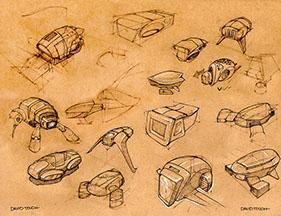
Part 1 studies by student, Erica Negron, Summer 2013. Using white Prismacolor pencil on black Canson. This organization is clustered and a good demonstration of draw-through technique. Excellent, examples of
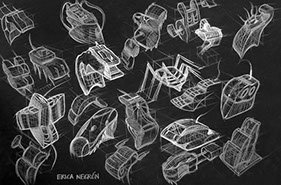
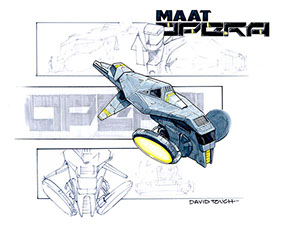
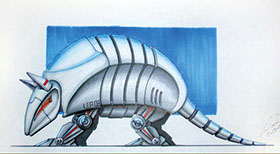
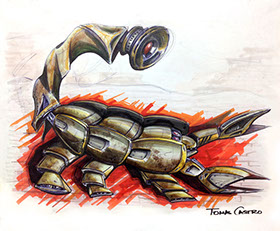
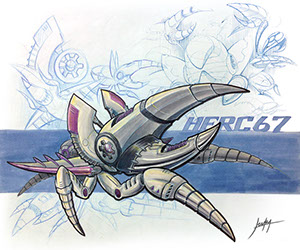
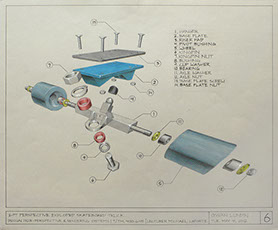
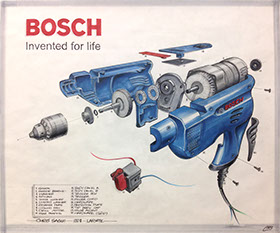
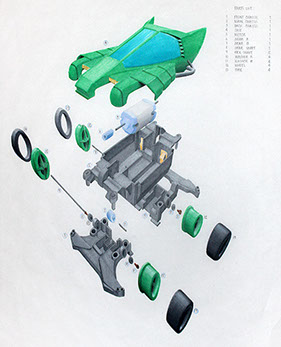
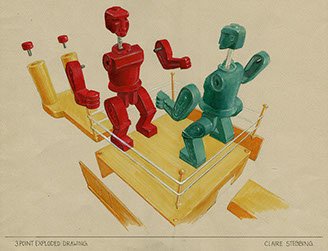
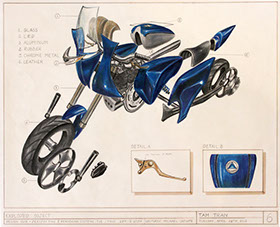
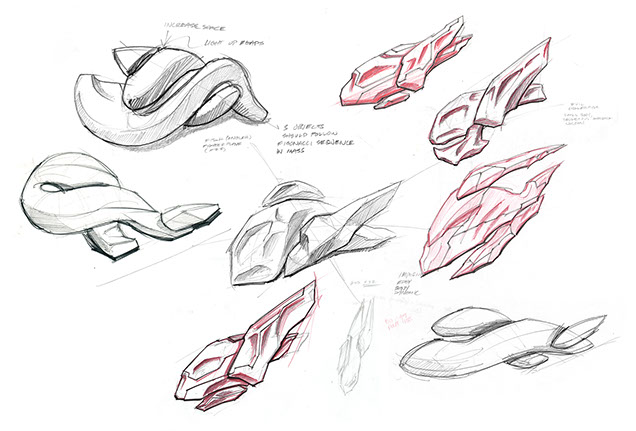
Part 2 by Jecky Chow Chen. Fall 2014
Examples of Exploded Assembly drawings, not from this project, but for reference of concept only.
Part 2 by Tomas Castro. Fall 2014
Part 2 by Christian Pacpaco. Spring 2012
Part 2 Finished piece by David Touch, with highly stylized graphic text treatment. Summer 2013
PART TWO
EMOTIVE RENDERING(S)
Be Persuasive in your stylization.
From your Exploratory Sketches, Generate 4 styling sketches—Articulate symmetry, asymmetry, aggressive, friendly. Once the configurations are ready, directed gesture drawing is used to generate a Second Set of 4 styling sketches. The 8 sketches are synthesized into 4, refined approaches, with a FINAL 2 presentation drawings fully rendered.
You should use Marker Paper or you may use an alternative paper such as a mid-tone Canson, using white pencil for highlights.
Include the name of the class, instructor, your name in small text
Add your signature, either now or in as a separate add to Photoshop.
Create a unique identity to your machine. Perhaps derived from
the Latin Root for the animal you began with.
Include a brief description of the assignment in your own designer's
lettering—be sure to identify the animal type you were originally inspired by. BE SPECIFIC, not generic.
Choose one to "HERO" drawing
to enlarge and render fully expressing surfaces that are smooth and rough, surfaces which are dull and high polish or chrome.
PART THREE
EXPLODED ASSEMBLY DRAWING
After you've designed the exterior surfacing look of your animal-based machine(s), take one apart to evaluate the sub-structure and surfacing.
Create an Exploded Assembly Drawing of your machine in 2- or 3-pt perspective (render sparingly).
Your exploded assembly drawing should have a minimum of 20 parts, not including small fasteners and hardware. Focus on the Surface forms and internal mechanisms.
Include Info-Graphics to articulate movements and actions, as necessary.
See examples of Exploded Assembly drawings on the Facebook Portfolio 3-Pt Exploded Objects
See 132B assignment for additional help.
See more on the LaForteClasses Facebook page
Rendering by Christian Pacpaco.
Rendering by Claire Stebbing. Fall 2012
Rendering by Chris Sagui. Spring 2016
Rendering by Tam Tran. Spring 2012
Professional work by Daniel Simon for the Bubble Ship VTOL in Oblivion with references to dragonflies and medic choppers.
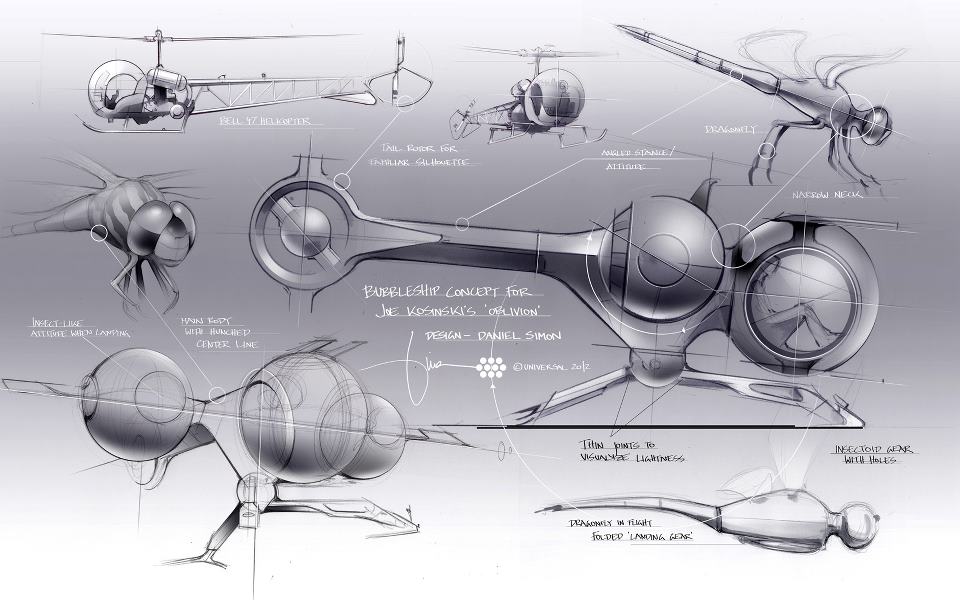
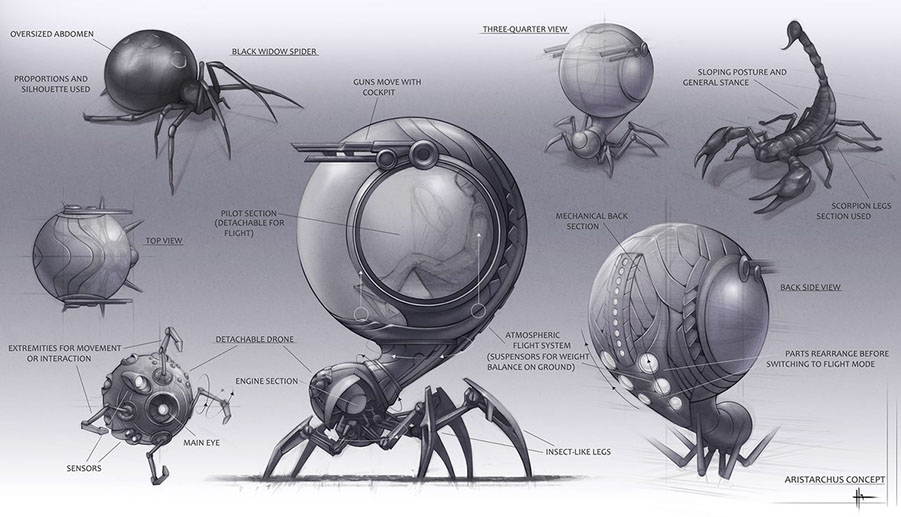
ANNOTATION IDEAS
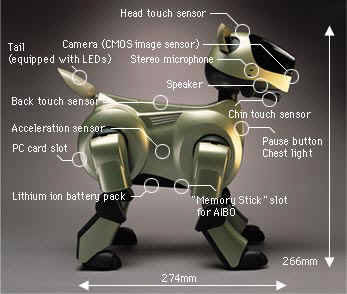
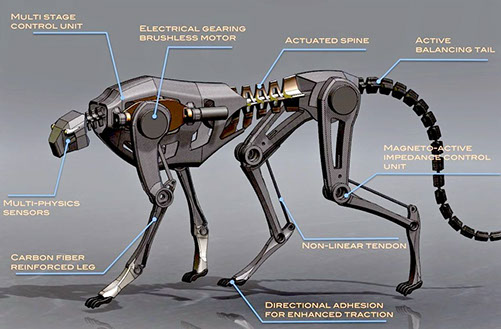
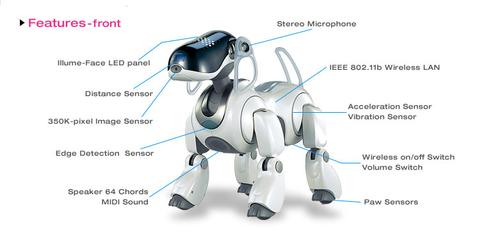
REFERENCES AND INSPIRATION
Application: Tesla "Snake" charger
BOOKS
Sketching The Basics, Chapter 7.7, p.196 is a good example of transformation from a dragonfly
To Draw Is To See. Norm Shureman's sketchbook on Blurb
STYLE
HR Geiger. The master of sci-fi creature design, creator of Alien and Prometheus environments.
Trigger Warning, Geiger's work is highly sexually charged and may be disturbing for some.
VW Contest winner, Nuclear Warp
Star Wars, AT-AT (All Terrain Armored Transport)
Chris Bangle, designer for BMW on the attitude and stance of the BMW X6
Mech Design (google search link)
Simon Stålenhag - WOW!
Steam Punk. A helpful aesthetic for creating mechanical looking things
ARTICLES
Utopia or Dystopia
Robots will destroy our jobs – and we're not ready for it. The Guardian
Welcoming Our New Robot Overlords. The New Yorker
Japanese construction robot demonstrates the future of building. New Atlas
MIT engineers replace chefs with machines at "world's first" robotic kitchen. Dezeen
Welcome to the automated warehouse of the future. The Verge
These misbehaving robots are designed purely to annoy you. Dezeen
Neri Oxman's swarm of Fiberbots autonomously build architectural structures. Dezeen
Why Westerners Fear Robots and the Japanese Do Not. Wired
Disney has made flying stunt robots that can pose like superheroes in midair. Business Insider
Friendly/Approachable
Meet Moxi, The Hospital Robot. BBC News
Meet Little Casper, a robot designed to help children suffering from cancer. EuroNews
Kuri is an "insanely cute" home robot with its own facial expressions. Dezeen
Literalism
Manta ray-like drone offers "graceful" alternative to underwater robots. Dezeen
New Seagull-Like Robot Spy Drone! Fast Company
Boston Dynamics to start selling SpotMini robot as soon as 2019. Dezeen
Identity Politics
It's Time to Talk About Robot Gender Stereotypes. Wired
Robots and Racism: We discriminate against 'darker-coloured' humanoids, study finds. EuroNews
Cyborgian Discourse
How to Become the Engineers of Our Own Evolution. Smithsonian Magazine
You Are Cyborg. Wired
Cyborg America: inside the strange new world of basement body hackers. The Verge
How Humans Are Shaping Our Own Evolution. National Geographic
ROBOTICS COMPANIES, SOME
Boston Dynamics
SONY
Science Fiction Films: Chappie, Terminator, Alien, Prometheus, Wall-E, iRobot, MANY more
CRITICAL THEORY/PHILOSOPHY
Deleuze and Guattari: Two Meditations. by Arthur Kroker originally published in The Posessed Individual. New York: St. Martin's Press, 1992.
STUDENT LEARNING OUTCOMES
- The ability to draw upon inspiration for form logic from nature,
- The ability to explore a variety of options before committing to
a final solution, - The ability to create a machine that retains identifiable characteristics,
- The ability to examine difference through repetition.
GRADING AND EVALUATION RUBRIC
The following Rubric applies in assessment of the student's work product, presentation, and/or process:
^
* Estimate only. See instructor and calendar for specific due dates. Summer Session schedule is more compressed with one week equal to approximately two and half semester weeks.
CSULB | COTA | DEPARTMENT OF DESIGN | BIO

Questions, feedback, suggestions?
Email me with your recommendations.
©2020 Michael LaForte / Studio LaForte, All Rights Reserved. This site and all work shown here is purely for educational purposes only. Where ever possible student work has been used or original works by Michael LaForte.
Works by professionals found online or in publication are used as instructional aids in student understanding and growth and is credited everywhere possible.